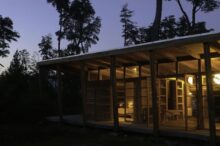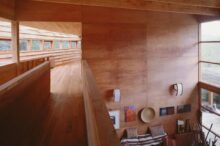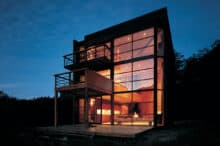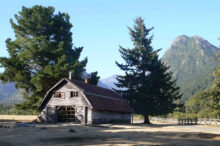
“On the banks of a river, the Lonco and leader of a Mapuche community, accustom to reflect about the posible name of a place, in this case as he walked the Lonco proposed that they listen to the river and instantly, they see a white horse come out of the water”
In Mapudungun;
Kawellu: Horse y Co: Water
Thats how Kawelluco is born.

Kawelluco is a ruralization that, unlike urbanization, responds to the dismantling of the city, not as a design but as a way of living in a community. The dispersed energy from an old forestry operation was used for the conservation of a native park 10 km from the town of Pucón.
The landscape was wounded. The air of the mountains remained. But the exploitation of wood is indifferent to a volcano, Villarrica could destroy the area, again and again.
Consequently, geographical accidentity is accepted and a network of paths and squares is created. Of the total land, 600 hectares are a nature reserve and the remaining 396 are destined for ruralized sites, whose minimum subdivision unit is one hectare.
In Kawelluco three typologies of houses were created by Cazú Zegers: Casa Talleres, Unidades de Conquista and Galofts.
Ruralization
It can be traced back to medieval times in relation to the use of urban planning practices in the countryside. Although this is not a concept created by Cazú Zegers, the architect has developed an architectural methodology within ruralization, creating spaces that respect balanced development between the natural environment and human intervention. With this execution it is possible to maintain the natural attributes of the territory. It differs from urbanization, which is defined as the action and effect of the set of buildings erected to build and organize a formerly rural land. Ruralization seeks to preserve the rural qualities and the native landscape of the place, generating small interventions so that human beings can inhabit a place in a respectful manner.
Casa Talleres
"Casa Taller" is a typology that Cazú Zegers developed in conjunction with the ruralization of Kawelluco in the nineties and beginning of the millennium. People from various trades and professions came to live there, many of them artists. The Workshop Houses are an architectural proposal that intends the program and its interior to provide the artist with an optimal work space.
Unidades de Conquista
Understood today as a “tiny-cabin” or “tiny-house” by Cazú Zegers. This is characterized by being the minimum unit necessary to inhabit a territory, designed from a unique gesture that dialogues and builds tension with the surrounding landscape.
Galofts
The word "Galpón" can find its origin in the Mexican macro language Nahuatl to refer to "Calpulli" = Family clan or communal house. The word "Loft" has a North American origin to describe large spaces with few divisions.
Proyectos Kawelluco
-
Casa Granero
2004

-
Casa Té 1A
2002

-
Casa Silencio
2000

-
Casa Taller Cubo
1999

-
Casa Fogón
1997

-
Casa Santa María
1998







